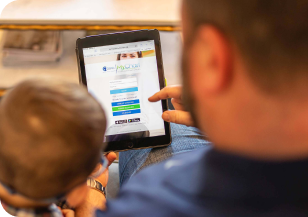GIVE NOW before 2025 ends—your gift will be doubled to help children in need. Click here to 2x your impact!

Ranked nationally in pediatric care.
Arkansas Children's provides right-sized care for your child. U.S. News & World Report has ranked Arkansas Children's in seven specialties for 2025-2026.

It's easier than ever to sign up for MyChart.
Sign up online to quickly and easily manage your child's medical information and connect with us whenever you need.

We're focused on improving child health through exceptional patient care, groundbreaking research, continuing education, and outreach and prevention.

When it comes to your child, every emergency is a big deal.
Our ERs are staffed 24/7 with doctors, nurses and staff who know kids best – all trained to deliver right-sized care for your child in a safe environment.

Arkansas Children's provides right-sized care for your child. U.S. News & World Report has ranked Arkansas Children's in seven specialties for 2025-2026.

Looking for resources for your family?
Find health tips, patient stories, and news you can use to champion children.

Support from the comfort of your home.
Our flu resources and education information help parents and families provide effective care at home.

Children are at the center of everything we do.
We are dedicated to caring for children, allowing us to uniquely shape the landscape of pediatric care in Arkansas.

Transforming discovery to care.
Our researchers are driven by their limitless curiosity to discover new and better ways to make these children better today and healthier tomorrow.

We're focused on improving child health through exceptional patient care, groundbreaking research, continuing education, and outreach and prevention.

Then we're looking for you! Work at a place where you can change lives...including your own.

When you give to Arkansas Children's, you help deliver on our promise of a better today and a healthier tomorrow for the children of Arkansas and beyond

Become a volunteer at Arkansas Children's.
The gift of time is one of the most precious gifts you can give. You can make a difference in the life of a sick child.

Join our Grassroots Organization
Support and participate in this advocacy effort on behalf of Arkansas’ youth and our organization.

Learn How We Transform Discovery to Care
Scientific discoveries lead us to new and better ways to care for children.

Learn How We Transform Discovery to Care
Scientific discoveries lead us to new and better ways to care for children.

Learn How We Transform Discovery to Care
Scientific discoveries lead us to new and better ways to care for children.

Learn How We Transform Discovery to Care
Scientific discoveries lead us to new and better ways to care for children.

Learn How We Transform Discovery to Care
Scientific discoveries lead us to new and better ways to care for children.

Learn How We Transform Discovery to Care
Scientific discoveries lead us to new and better ways to care for children.

When you give to Arkansas Children’s, you help deliver on our promise of a better today and a healthier tomorrow for the children of Arkansas and beyond.

Your volunteer efforts are very important to Arkansas Children's. Consider additional ways to help our patients and families.

Join one of our volunteer groups.
There are many ways to get involved to champion children statewide.

Make a positive impact on children through philanthropy.
The generosity of our supporters allows Arkansas Children's to deliver on our promise of making children better today and a healthier tomorrow.

Read and watch heart-warming, inspirational stories from the patients of Arkansas Children’s.

Hello.

Arkansas Children's Hospital
General Information 501-364-1100
Arkansas Children's Northwest
General Information 479-725-6800


10-Year-Old Hewitt Fights Rare, Malignant Cancer with Compassion, Confidence
Published date: August 22, 2023
Early Signs of Cancer
Hewitt Kahana loves school. Shaw Elementary in Springdale, Arkansas, is where he gets to hang out with friends, and he’s an excellent student. Hewitt isn’t the kind of kid who fakes an illness to avoid going to school, so when his teacher messaged to say the 10-year-old had been putting his head down during class, his parents knew something was wrong.
“The day I made the appointment to see our primary care physician at Arkansas Children’s Northwest (ACNW) was the day he didn’t want to go to school,” Hewitt’s mother, Christen Sluyter, said. “He asked if he could sleep in. He threw up three times that day [even though] he hadn’t eaten anything weird.”
Hewitt had also complained of light sensitivity and recurring headaches. His parents suspected migraines or the possibility that Hewitt might need glasses. They shared their concerns with their pediatrician, Andrew Hamby, M.D. “He really took the time to listen to what we had to say. He didn’t dismiss any of it.”
An MRI scan – a non-invasive imaging technique used to produce detailed 3-D images – of Hewitt’s head was scheduled for a Friday. Hewitt’s father, Jared Sluyter, said he expected it to be a quick procedure and began to worry when more detailed scans were needed.
That Friday evening, as they were driving home, the Sluyters got a call from Tomoko Tanaka, M.D., a pediatric neurosurgeon at Arkansas Children’s and an associate professor in the division of pediatric neurosurgery in the Department of Neurosurgery at the University of Arkansas for Medical Sciences (UAMS).
They pulled over, and Tanaka told them the source of Hewitt’s headaches and nausea was not migraines or poor vision; it was a tumor. He would need surgery as soon as possible, and she would be their surgeon.
Jared said his first thought was, “This is where our whole life changes. This is the start of that hard thing. I was very scared.”
Hewitt’s Cancer Journey
‘That hard thing’ began when the MRI revealed a baseball-sized tumor near the base of Hewitt’s skull. They didn’t know at the time whether the tumor was benign or malignant, just that it had to be removed. One of Christen’s first realizations was that she wanted Hewitt to have some control over the situation. “This is his life and his experience,” she said. “It became really important to me that Hewitt felt that he was prepared.” That night, she told him about the tumor, the surgery and everything they did and didn’t know about the cancer.
Hewitt is the oldest of three children, and his first response was to support his younger brother and sister. Christen said, “With so much calm maturity, he sat his siblings down. The first thing he said was, ‘I don’t want you to be worried.’”
Throughout his cancer journey, Hewitt became known for caring for those around him, especially his brother and sister, while undergoing radiation treatment or chemotherapy or traveling to different hospitals.
Hewitt’s top priority was his siblings, but school, friends and classmates were always on his mind. Jared said, “When Hewitt found out about his initial surgery, his main concern was, ‘Can I get back to school for Lemonade Wars?’”
Craniotomy
The family’s first cancer-related trip was to Arkansas Children’s Hospital (ACH) in Little Rock. Three days after receiving the phone call, Dr. Tanaka performed a five-hour craniotomy, successfully removing the tumor. Between the preparations for surgery, the craniotomy, and the post-operative monitoring, Hewitt spent seven days at ACH.
“There are so many moving parts and people and roles and places in that hospital,” Christen said. “It was really encouraging to see everybody working together.” ACH is a large facility, but she said, “Feeling like there was a team, and there was a plan...really grounded me as a parent.”
After the surgery, tumor tissue samples were sent to the lab to identify the specific type of cancer. Tumors in children differ from adult tumors in significant ways. According to the World Health Organization, “Unlike cancer in adults, the vast majority of childhood cancers do not have a known cause.” This makes preventing pediatric cancers very difficult, requiring doctors to focus on treatment. Proper treatment depends on having a clear description of the type of tumor.
When the lab results arrived, the news wasn’t good. Officially, Hewitt’s tumor was a “high-grade neuroepithelial tumor with a BCOR alteration.” This classification was helpful information for his oncologist and the care team trying to prevent cancer from returning. For his parents, those technical terms translated into three critical facts. The cancer was rare, malignant and fast-growing.
Proton Beam Therapy
Another key difference between malignant tumors in children and adults is that children’s bodies are still growing. Radiation that destroys cancerous cells can also damage developing organs and tissue, potentially impacting a child’s growth. Proton beam therapy – the safest radiation treatment for pediatric patients because it does less damage to surrounding tissue – wasn't available in Arkansas at the time. Families like Hewitt’s are the reason Arkansas Children’s partnered with UAMS, Baptist Health and Proton International to bring a proton center to Little Rock in 2023.
For Hewitt’s radiation therapy, the family went to Texas. They spent the summer of 2022 in the Dallas area because the next step in Hewitt’s cancer journey was 30 sessions of proton beam therapy.
Jared and Christen said Hewitt helped make the family’s time in Texas feel like a vacation for his siblings by playing games and focusing on the fun activities available in Dallas. Back home in Arkansas, friends and family helped keep morale high by finding ways to support the Sluyters.
Chemotherapy
When Jared and Christen received that first call about the tumor, they feared the care Hewitt needed would require them to move the entire family to a different city or state. One of the biggest comforts came when they realized Arkansas Children’s Northwest (ACNW) would provide Hewitt’s chemotherapy treatment, only a 10-minute drive from the Sluyter’s house. Jared said it was a relief to be near home but an even more significant relief that ACNW and ACH are part of the Arkansas Children’s statewide health network. He said the “culture of excellence” evident in Arkansas Children’s facilities gave them peace of mind, especially as they made tough decisions about Hewitt’s care.
“Because of the challenging nature of Hewitt’s cancer, we were given some options. The very hard thing about his cancer is you almost always just get one shot at it. You can choose how much chemo you give and what types of chemo you give. We decided to go with the most aggressive chemo because it was a very aggressive cancer, and we would possibly only have one shot at it,” Jared said.
Hewitt’s surgery removed the large tumor. A combination of proton therapy and chemotherapy was needed to eliminate all the tiny cells that might allow cancer to return. Robert Saylors, M.D., chief of the medical staff and the medical director of the Hematology/Oncology program and the Infusion Center at ACNW and a professor of pediatrics in the Division of Pediatric Hematology/Oncology at UAMS led Hewitt’s aggressive chemotherapy.
While his classmates and friends were starting the school year, Hewitt started six months of chemotherapy. The treatment compromises the body’s immune system, which meant Hewitt would be isolated from friends and extended family most of the time.
Arkansas Children’s nurses and child life specialists became one of the most substantial sources of support for the Sluyters. With each new medication or phase of treatment, the nurses and child life specialists explained their purpose and the common side effects using age-appropriate terms. Jared was relieved to have a set of clear expectations. Christen said she was grateful for the emotional support too. “Just being asked, ‘Do you need anything?’ even if I didn’t...made a world of difference.”
Saylor’s said Hewitt’s body responded well to the treatment. However, Hewitt still had the typical side effects of nausea and the need for blood transfusions and antibiotics. All of this took a toll on Hewitt’s physical and mental stamina. He would get exhausted more quickly when playing with his brother and sister or when trying to concentrate on schoolwork. Despite those limitations, Hewitt was known throughout ACNW for his optimism and friendliness.
“Throughout all his stays with us, he did everything he could to make us feel better,” Saylors said. “He always had a bowl of candy in his room by the door [for the members of his care team]. When he found out what my favorite candy was, he made sure there was some of that in the bowl too.”
Ringing the Bell
On Monday, March 13, 2023, Hewitt received his final round of chemotherapy. When we asked what he looked forward to the most, Hewitt said, “I’ll get to go back to school and see all my friends again.”
When a pediatric patient finishes their cancer treatment at ACH or ACNW, the event is marked with a bell-ringing ceremony. Dozens of nurses, doctors, child life specialists and family members lined the halls of ACNW as Hewitt rang the bell that symbolized being cancer-free. Then, while everyone chanted, “No more, no more chemo!” to the tune of Queen’s “We Will Rock You,” Hewitt ran through a banner that said, “Cancer picked the wrong kid!”
The ceremony marks the formal end of chemotherapy, but Hewitt will continue to be seen at ACNW for follow-up visits for the next six years.
“No Evidence of Disease” (N.E.D.)
Three months after the bell-ringing celebration, when we sat down with Jared and Christen again, Hewitt still showed “No Evidence of Disease” (N.E.D.). Hewitt started playing baseball almost immediately after his last treatment, and a sense of normalcy was returning to the family.
Jared was quick to credit the initial surgery. “Dr. Tanaka is amazing. At this point in our journey, every single person we’ve talked to has said Hewitt’s healing is likely because she did such a good job.”
As Christen reflected on the journey, she said she remains grateful for the feeling of community Hewitt’s care team provided. She learned, “We don’t have to do hard things alone. That is what Arkansas Children’s has been for us – a surrounding of joy and hope.” Christen said, “This has been hard, but it has not been lonely.”
And Hewitt is doing what he loves again: riding bikes and hanging out with his friends. In the fall of 2024, he’s more excited than most children about going back to school.
Do It for Hewitt Fundraiser
Along with school and his family, Hewitt loves biking. The cycling community in northwest Arkansas is vibrant and supportive. Fellow cyclist and friend, Scotti Lechuga, organized a fundraiser – Do It for Hewitt – because costs for the Sluyters were beginning to mount. In addition to the summer in Texas, Jared and Christen traveled to Philadelphia for a second opinion on the best treatment for Hewitt’s cancer. Collectively cyclists rode over 30,000 miles and raised more than $55,000.
On each step of Hewitt’s cancer journey, the Sluyters crossed paths with other families with children going through their cancer journey. Informal and formal support networks grew with each stage of treatment. “Meeting other kids and families that are going through something similar...has been really enriching for Hewitt,” Christen said. “Having a community to walk through this with has been really beneficial.”
Hewitt's Fight With Cancer - A Rare, High Grade Neuroepithelial Tumor


Appointments
New and existing patients can visit our appointment hub for several ways to request an appointment, including online scheduling for many services.
Request an appointment
